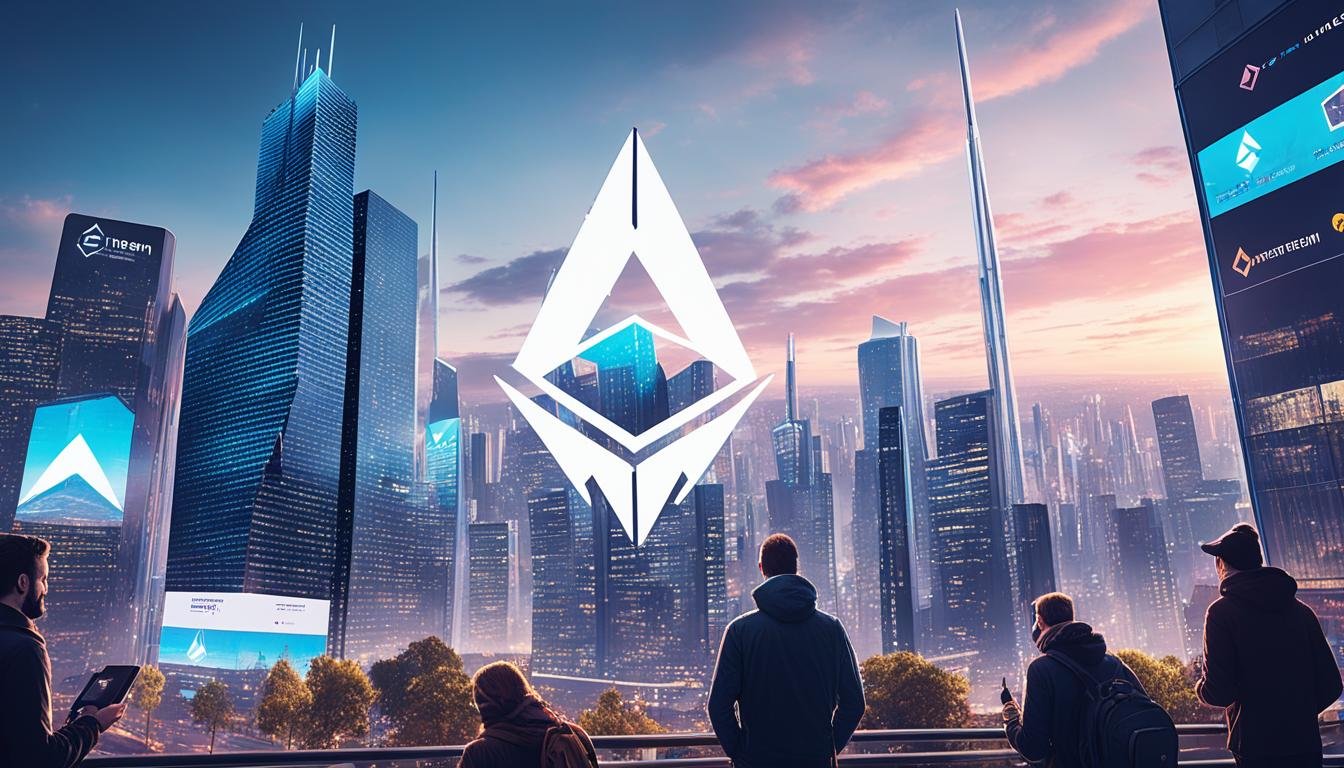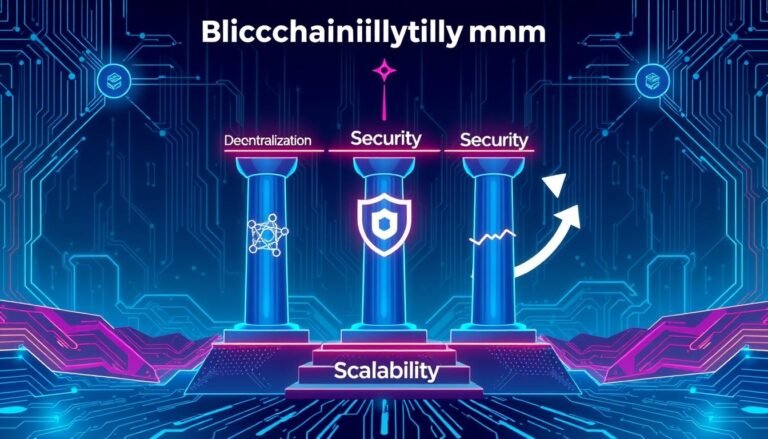Invest in Ethereum (ETH), the Decentralized Future
Did you know Ethereum’s value recently reached $3,207? This is down from its all-time high by 34.56% but up 0.70% over last week as of May 6, 2024. These big changes show how investing in Ethereum and its blockchain technology can be exciting.
Ethereum is more than just a popular ETH cryptocurrency. It’s a decentralized platform with a big future. Its value comes from being useful in different fields like decentralized finance (DeFi), smart contracts, and decentralized applications (dApps). The move from Proof-of-Work (PoW) to Proof-of-Stake (PoS) with Ethereum 2.0 has made it work better and save energy.
The future of this platform looks very good, with predictions of its value going up a lot by 2030. As it’s able to do more than just being a digital currency, it’s a great pick for those looking to spread their investments.
But, it’s important to know about the risks. The market can change a lot, and rules might shift too. Being smart and staying updated can help investors make the most of Ethereum.
Key Takeaways
- Ethereum’s value was $3,207 on May 6, 2024, showing recent growth and change.
- The change to Proof-of-Stake (PoS) with Ethereum 2.0 made it more efficient and eco-friendly.
- Experts think its value could go up to $20,500 by 2030.
- Ethereum works in DeFi, smart contracts, and dApps, making it valuable in many fields.
- It’s important to be aware of the market’s ups and downs and possible rule changes when investing in Ethereum.
What Is Ethereum?
The Ethereum platform is leading in crypto innovation. Beyond digital currency, it’s a decentralized computing network. Created by Vitalik Buterin and Gavin Wood in 2015, it uses blockchain tech. This supports many applications, from financial services to gaming.
Understanding the Core Concept
Ethereum is a distributed ledger without a central authority. It’s known for strong security through cryptographic methods. It allows the creation of digital assets and peer-to-peer networking.
Users can connect their computers directly. The platform uses smart contracts, which run without interference. This eliminates downtime, censorship, and fraud.
Founders and History
Vitalik Buterin and Gavin Wood created Ethereum. They aimed to go beyond Bitcoin’s limits. Ethereum introduced a virtual machine for any complete program.
Since 2015, Ethereum has grown to be the world’s second-largest cryptocurrency. It has a market cap of about $380 billion as of May 2024. Its blockchain reaches consensus every 15 seconds, much faster than Bitcoin.
How Ethereum Operates
Ethereum changes how transactions work on a decentralized network. Created in 2015, it is the foundation for many decentralized applications. Its founders, Vitalik Buterin and Joe Lubin, aimed to change how we do business.
Blockchain Technology
Ethereum uses blockchain technology at its core. This system checks and makes all transactions public and unchangeable. This makes the network safer and more transparent. It uses the ‘proof-of-stake’ method, called Gasper, since 2022. This is safer as it involves validators who risk some ETH to keep the network honest.
Decentralized Network
Ethereum works without the need for middlemen. This is unlike traditional networks that are controlled by a few. It is spread across many nodes worldwide, making it strong and secure. This freedom allows for different uses, from finance to gaming and VR.
Ethereum Virtual Machine (EVM)
The Ethereum Virtual Machine (EVM) is key to how Ethereum works. It’s the place where smart contracts operate. Smart contracts are code that can run on their own, making transactions when needed. This setup allows for many new ideas without a central controlling party.
“Danksharding” is a recent upgrade introduced in March 2024 to improve scalability on Ethereum. It aims to make transactions cheaper and faster. As of May 2024, over 120 million Ethereum coins are in use. This means the network keeps getting better for its users.
Key Features of Ethereum (ETH)
Ethereum stands out among other platforms with its unique features. These include smart contracts, dApps, and NFTs. They play a major role in Ethereum’s success in the DeFi and tokenization sectors.
Smart Contracts
Smart contracts are digital agreements that execute themselves. They’re written into Ethereum’s code.
Because of smart contracts, transactions can run automatically. This reduces costs and makes deals more secure. They’ve helped build decentralized organizations and changed digital deals.
Decentralized Applications (dApps)
dApps work on Ethereum without a central authority. They offer many services, like games, finance, and tracking supplies.
Ethereum supports these apps with its flexible system. This makes them safe, clear, and effective. DeFi on Ethereum has changed how we access financial products.
Non-Fungible Tokens (NFTs)
NFTs are special digital items, guaranteed by Ethereum. They’re unlike regular money, such as Bitcoin or Ether.
In 2021, NFTs became very popular. They’re used in digital art, music, games, and collecting items. This shows the many uses of Ethereum’s system.
Ethereum is all about making new things. It has made big changes, like moving to proof-of-stake. This makes it better for running lots of apps and is good for the environment.
The platform keeps updating, which makes it stay at the top in the world of dApps.
| Feature | Description | Benefits |
|---|---|---|
| Smart Contracts | Self-executing contracts coded on the blockchain | Cost-effective, secure transactions |
| Decentralized Applications (dApps) | Applications that run independently on the blockchain | Enhanced security, transparency, and efficiency |
| Non-Fungible Tokens (NFTs) | Unique digital assets verified on the blockchain | Ownership and provenance of digital assets |
The Economic Model: Ether (ETH)
By May 2024, Ether (ETH) holds the second spot among cryptocurrencies, worth about $380 billion. Its high value shows its key part in the blockchain world. It’s vital for many uses in blockchain technology.
More than being a part of the Ethereum network, Ether plays many roles. It’s used for investing, payments off the Ethereum network, and trading on crypto markets. People can also spend Ether at stores, which makes it very practical.
Utility and Use Cases
The value of Ether comes from its many uses in the blockchain. It powers dApps, runs smart contracts, and works with DeFi projects. Since October 2023, people can invest in Ether through funds like VanEck Ethereum Strategy ETF (EFUT). In May 2024, Ether spot ETFs were approved, giving direct access to ETH tokens and boosting crypto investments.
Supply Dynamics
Ether’s supply is different from Bitcoin. It doesn’t have a cap but has a yearly limit on how much can be released. This keeps Ether in steady supply, meeting the demands of the market and helping Ethereum grow.
Another unique feature is how its price is set, using systems that adjust as the supply changes. This encourages its early use and keeps the market stable.
Gas Fees
Gas fees on Ethereum cover the cost of processing transactions. They change with the network’s use and the complexity of transactions. When the network gets busy, these fees can go up.
Developers and users need to understand these fees. It’s key for planning and keeping costs under control when using Ethereum for different projects.
To sum up, Ether is vital for many blockchain activities and for investing. Its supply system and the way gas fees work are important. They shape how useful and valuable Ethereum is, calling for careful management.
Consensus Mechanisms: From PoW to PoS
Ethereum made a big change from Proof-of-Work (PoW) to Proof-of-Stake (PoS) consensus. This move is a major step forward in Ethereum’s development. Before this change, Ethereum used as much energy as Singapore and Bangladesh together. It also created as much CO2 as 5.1 million cars every year.
On September 15, 2022, Ethereum completed its move to PoS from PoW. Now, to help validate transactions, ETH validators must lock up at least 32 ETH. This change has made Ethereum much more efficient.
After the merge, Ethereum’s energy use dropped by more than 99%. Meanwhile, its ability to process transactions grew significantly. Before, it could only handle 15 transactions per second (TPS). Now, it can do over 64 times more. With almost a million validators, it’s easier for more people to join in. All you need is a common device and internet.
The shift to PoS has also made Ethereum a leader in eco-friendly blockchain technology. It supports the goal of sustainable development. Now, let’s compare how PoW and PoS have affected Ethereum:
| Aspect | Proof-of-Work (PoW) | Proof-of-Stake (PoS) |
|---|---|---|
| Annual Energy Consumption (TWh) | 50.63 | 7.5 |
| Carbon Footprint (million tonnes of CO2) | 23.86 | Minimal |
| Transaction Capacity (TPS) | 15 | 960+ |
| Required ETH for Validators | N/A | 32 ETH |
| Number of Validators | N/A | 925,000 |
After the merge, Ethereum’s running costs went down. This makes it more affordable for many more people. It’s all part of Ethereum’s plan to be sustainable and open to everyone. This change shows that Ethereum is actively creating a future for blockchain that is scalable and fair.
The Benefits and Challenges of Investing in Ethereum
Investing in Ethereum offers great chances and certain obstacles, thanks to its role in blockchain. To wisely choose whether to invest, one must grasp these aspects well.

Potential Returns
The DeFi sector is booming, driving Ethereum’s value above $4,000 in 2020 and 2021. Experts foresee Ethereum’s token price hitting $11.8k by 2030. This suggests a bright future for Ethereum and potential long-term growth for investors.
Ethereum’s prominence is evident, with 10 of the top 20 cryptocurrencies using its network. This shows Ethereum’s strong foundation and vast possibilities.
Risks Involved
Pursuing gains in Ethereum comes with clear investment risks. The 2016 DAO hack, which saw $50 million stolen, warns of the security dangers. Also, evolving regulations might unexpectedly alter the investment landscape.
Ethereum’s move from Eth1 to Eth2 aims to enhance efficiency and reduce fees. Yet, this shift may bring about some instability.
Market Volatility
Cryptocurrencies, like Ethereum, are famously volatile. Ethereum peaked at $1,400 in early 2018 but has shown unpredictable price swings. Despite its diverse applications, Ethereum isn’t shielded from market shake-ups.
To navigate these risks, smart and careful investment tactics are necessary. Balancing potential rewards with crypto’s market turbulence is key. This highlights the importance of a well-thought-out investment plan.
Ethereum’s Competitive Advantages
Ethereum keeps ahead in the blockchain world with its active community and never-ending quest for new ideas. It also succeeds with its smart ways to handle more transactions without overloading.
Large Community and Ecosystem
Ethereum brings together a big group of developers, validators, and users. This community makes various projects happen, including those in DeFi, and helps Ethereum stay ahead. It plays a key role in the $31.5 billion locked in DeFi projects.
Constant Innovation
Ethereum is always evolving since its start in 2015. It introduced the Ethereum 2.0 upgrade to tackle energy use concerns with mining. Now, with options like Polygon and Optimism, it’s setting new standards in making transactions smoother and more affordable.
Scalability Solutions
One of Ethereum’s big hurdles is how many transactions it can handle at once, around 15-30. This often leads to network issues and high fees. But, it’s working on solutions to improve this, making transactions faster and cheaper. While some, like Solana, process more transactions, Ethereum’s overall strategy makes it a leader in building a lasting place in the crypto world.
Long-Term Price Predictions and Market Outlook
The Ethereum long-term forecast looks promising. Major growth is expected in its value. As of May 6, 2024, Ethereum is valued at $3,207, which is 34.56% lower than its peak. Yet, it shows a 0.70% increase last week. The current market capitalization is $384.09 billion.
The Shapella upgrade in April 2023 boosted ETH’s value from $2,100 to $4,000. After the Dencun upgrade on March 13, 2024, its value increased by 0.80% in a week. This upgrade and others have had a positive impact on the market.
Ethereum has had various value changes showing its potential over the years. Since its launch in July 2015, it has seen great highs. For example, it went from above $18 in 2016 to $1,400 in 2018. Despite some drops, it hit $4,362 in 2021 and $4,090 in 2024.
The end of 2024 could see ETH valued at $5,000. Throughout 2025, prices could range from $4,500 to $6,500. Experts even see a chance for it to reach $40,000 by 2030.
ETH has shown strong performance against Bitcoin. It achieved a near 400% gain in 2021, beating Bitcoin’s 66%. Recent blockchain upgrades have been significant in these improvements.
“By June 2024, Ethereum’s price might reach $3,850 due to high investor confidence. Predictions for 2024 range from $5,071 to $5,871 on average,” as Coinpedia says.
If the crypto market cap hits $3 trillion by 2025, Ethereum could reach over $3,600. In a very positive scenario by 2030, it might even surpass $12,000. However, in a less optimistic view, it could struggle to go past $6,135 with the same market cap.
| Year | Predicted Price Range | Average Price Prediction |
|---|---|---|
| 2024 | $5,907 – $7,194 | $5,871 |
| 2025 | $4,500 – $6,500 | $5,500 |
| 2030 | $38,664 – $47,066 | $40,000 |
The outlook for ETH prices is reasonably hopeful. It suggests watching for upgrades and market expansion. Investors should stay informed about the market’s ups and downs. They should balance their hopes with realistic understanding of the market.
How to Buy and Store Ether (ETH)
Starting to buy Ether (ETH) means picking the best crypto exchange. Top exchanges like Binance, handling $21.15 billion in trades by May 28, 2024, and Coinbase, the best in the U.S., are solid choices. They have great features and fees around 1% for each buy. You can use bank deposits, wire transfers, debit cards, and PayPal on these platforms.
Choosing a Cryptocurrency Exchange
When picking an exchange, think about security, convenience, and fees. Binance is a big name that lets you buy with credit/debit cards, Google Pay, and Apple Pay. However, using a credit card may mean extra charges. The beauty of crypto is you can trade anytime, all week. But, you must confirm your buy quickly, to secure the current price.
Using Digital and Hardware Wallets
Keeping your Ether safe is very important. Digital wallets are great for trading often because they’re online. But if you plan to hold your Ether for a while, go for a hardware wallet. They’re offline, which is safer. Also, big exchanges keep some of your assets offline and offer insurance. This protects you from digital theft.
Ethereum costs about $3,850 per token and has over 120 million coins available. Making smart choices about where and how to store your Ether is key. With the right exchange and wallet, you can feel safer about your crypto in a fast-changing market.
FAQ
What is Ethereum?
How does Ethereum operate?
What are smart contracts?
What are decentralized applications (dApps)?
What are non-fungible tokens (NFTs)?
What is the utility of Ether (ETH)?
What are gas fees?
What is proof-of-stake (PoS) in Ethereum?
What are the potential benefits of investing in Ethereum?
What are the risks involved in investing in Ethereum?
What are Ethereum’s competitive advantages?
What are the long-term price predictions for Ethereum?
How can I buy and store Ether (ETH)?
Source Links
- https://www.forbes.com/advisor/in/investing/cryptocurrency/ethereum-price-prediction/
- https://www.investopedia.com/tech/what-ether-it-same-ethereum/
- https://www.vaneck.com/us/en/blogs/digital-assets/ethereum-investment-case/
- https://consensys.io/knowledge-base/ethereum
- https://www.investopedia.com/terms/e/ethereum.asp
- https://www.forbes.com/advisor/investing/cryptocurrency/what-is-ethereum-ether/
- https://aws.amazon.com/blockchain/what-is-ethereum/
- https://nextrope.com/economics-of-ethereum-analysis/
- https://blog.bake.io/why-did-ethereum-switch-to-proof-of-stake/
- https://wirexapp.com/blog/post/from-pow-to-pos-the-ethereum-merges-game-changing-impact-explained-0787
- https://www.coindesk.com/learn/what-is-the-merge-and-why-has-it-taken-so-long/
- https://www.litefinance.org/blog/for-beginners/how-to-trade-crypto/is-ethereum-good-investment/
- https://www.forbes.com/advisor/in/investing/cryptocurrency/advantages-of-cryptocurrency/
- https://blog.pantherprotocol.io/ethereum-competitors-advantages-and-disadvantages/
- https://worldcoin.org/articles/ethereum-competitors
- https://fxopen.com/blog/en/analytical-ethereum-price-predictions-for-2024-2030/
- https://www.tokenmetrics.com/blog/ethereum-eth-price-prediction-2025-2030
- https://www.investopedia.com/news/how-do-i-buy-ethereum/
- https://www.forbes.com/advisor/investing/cryptocurrency/how-to-buy-ethereum/
- https://www.binance.com/en/how-to-buy/ethereum






